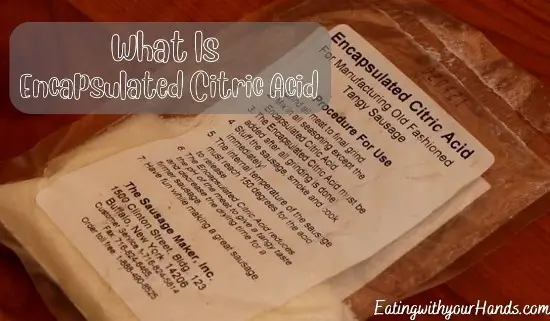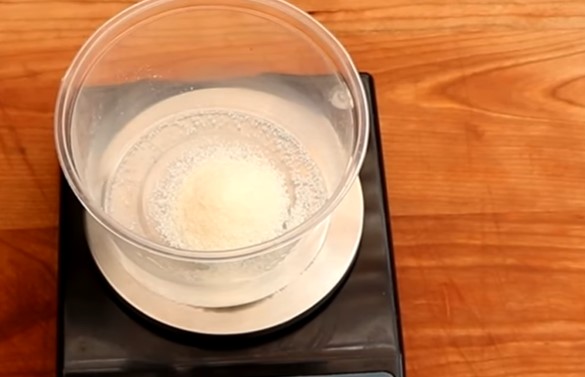If you’re a big fan of sausages, you probably already understand how important it is to get that perfect balance of acidity in spice and the meat blend to make your sausages taste amazing and last longer.
But guess what? There’s a nifty trick you might not know about: encapsulated citric acid, or ECA. It’s like a secret thing for getting that tangy flavor and making your sausages stay fresh for a lot longer – and it works super fast!

Table of Contents
What is Encapsulated Citric Acid?
It’s essentially regular citric acid but with a special coating made of either hydrogenated vegetable oil or maltodextrin. You see, citric acid is the natural substance found in oranges, lemons, and limes that gives them that zesty kick.
Now, when you use encapsulated citric acid in making sausages, it acts as a potent acidifier, lowering the pH level of the meat. This is helpful because it aids in breaking down the tough connective tissues in the meat, resulting in a better sausage texture.
The coating on the ECA acts as a shield. It prevents the acid from immediately affecting your sausage’s texture. It patiently awaits the right moment.
Then, when you cook your sausage and it reaches a temperature of at least 150°F or 135°F (depending on the type of sausage), that coating melts away. That’s when the citric acid finally gets to work, reducing the pH level, enhancing the meat flavor, and preserving it. It’s like a culinary magic trick!
Why Use ECA?
If you’re into making sausages that undergo a heat-processing method instead of dry-aging, encapsulated citric acid is the ingredient you should go for. Its clever coating ensures that it doesn’t spring into action as soon as it comes into contact with the meat and spices.
This provides you with the time you need for the sausage-making process and portioning without any premature acid reactions.
But that’s not all – this coating also functions as a protective shield against bacteria. This is a significant advantage because it considerably extends the sausage’s shelf life and helps keep those pesky bacteria at bay.
So, not only does it enhance flavor and texture, but it also acts as a built-in preservative for your sausages. Pretty neat, isn’t it?
How Much Encapsulated Citric Acid Per Pound of Meat?

You’ll want to use about 4 ounces of it for every 25 pounds of meat. That’s a pretty cost-effective choice for those in the sausage-making game.
Citric acid is one of those strong yet gentle natural acids. You don’t need a ton of it to make a real difference in the meat’s pH level. Just this small amount is sufficient to give your sausages that classic tangy flavor, especially if you’re aiming for that summery sausage taste.
So, it’s a ‘less is more’ situation, which is quite convenient for sausage makers.
How Does ECA Compare to Lactic Acid?
While there are some subtle distinctions between citric acid and lactic acid (which is released during the fermentation process), with careful processing and portioning, encapsulated citric acid, or ECA for short, can pretty much nail that taste.
In other words, you can achieve the same tangy flavor and a longer shelf life, just as you would with traditional fermentation methods. The significant advantage here is that you save yourself the extra time and effort that fermentation typically demands.
So, it’s like achieving the same delicious results with a shortcut – a win-win for the makers!
Is Encapsulated Citric Acid a Cure Accelerator?
Encapsulated citric acid is indeed a fantastic addition to meat curing, but it can’t replace curing salts as a cure accelerator.
Instead, ECA plays a crucial role in food preservation and flavor enhancement. It excels at extending the shelf life, enhancing taste, and improving the texture of cured foods.
Furthermore, it has a neat trick up its sleeve when it comes to cooking – by increasing the meat’s acidity, it can actually expedite the cooking process.
So, while it’s not a cure accelerator like curing salts, it remains a valuable tool in the realm of food preservation and flavor enhancement.
The Limitations of ECA as a Cure Accelerator
While ECA offers plenty of advantages, it cannot substitute for curing salts, specifically nitrates, when it comes to accelerating the curing process.
Here’s why: In the dry-curing process, nitrates undergo a transformation into nitric oxide, but this transformation occurs at a temperature lower than the dissolution point of ECA. As a result, the ECA powder remains enclosed in its capsule and doesn’t play a role in the curing process.
So, when you need to accelerate the curing process, curing salts like nitrates are still the preferred choice.
The Importance of a Proper Curing Agent
When it comes to curing meat, having the right curing agent is absolutely crucial. Two excellent options are smoked meat stabilizers and sodium erythorbate.
Alternatively, you can include regular citric acid as part of the mix. However, it’s vital to understand that while ECA can help prevent spoilage, it should never be the sole curing agent you rely on.
To ensure effective curing, it’s best to use a curing agent alongside ECA.
Using Unencapsulated Citric Acid
In case you ever find yourself without encapsulated citric acid but need to safeguard your meat during the curing process, let’s dissolve unencapsulated citric acid in hot water and incorporate it into your mixture. This can serve as a handy alternative when you’re in a pinch.
However, the ideal approach is always to use a curing agent.
The Benefits of ECA in Meat Curing
ECA has the remarkable ability to reduce the pH level of meat to a point where it undergoes effective curing. This process significantly extends the meat’s shelf life when compared to regular.
Furthermore, ECA imparts a distinctive tangy flavor to cured meat that many people find quite appealing.
So, while it might not do everything on its own, it’s a valuable ingredient in the meat-curing process, contributing to both preservation and flavor enhancements.
Why Use Encapsulated Citric Acid Instead of Regular Citric Acid?
Using citric acid on meat can cause an immediate breakdown of muscle tissues and connectives, resulting in an undesirable change in texture. This is precisely where ECA comes in handy.
With ECA, the acid remains contained within its protective coating until it reaches the right temperature. This controlled release is essential for achieving the desired texture in your meat.
So, when should you use ECA? It’s best to incorporate it later after the meat has been adequately cured. Using it too early or mixing it with regular citric acid can significantly impact texture and taste. Your meat might end up dry, crumbly, and white, making it challenging to shape into proper sausages.
You can still put encapsulated citric acid (ECA) to good use with fresh meat, especially game. By mixing it with water, you can help prevent the growth of bacteria and keep the meat from spoiling or decaying.
Remember, encapsulated citric acid (ECA) only springs into action at temperatures above 135°F to 150°F. So, it’s not the best choice for the initial treatment of your sausage mix. Instead, you can melt the capsules separately using hot water and then blend them into your sausage mixture.
Both regular citric acid and encapsulated citric acid have their roles in meat preparation. However, if you desire more control over the release of acid and the final texture of the meat, encapsulated citric acid is the way to go. It’s like having precision in your flavor and texture game.
How Do I Use Encapsulated Citric Acid in Sausage?

You’re in the sausage-making game and looking to save your time without sacrificing flavor? Look no further than ECA.
ECA is a game-changer because it adjusts the pH level and significantly reduces cooking time. But here’s the thing: you need to use it correctly to avoid ending up with unappetizing results.
Unencapsulated citric acid, if not handled properly, can dissolve tissue and affect the texture of the meat.
So, here’s your step-by-step guide to making sausage with ECA:
- Grind meat: Start by thoroughly grinding your meat before adding ECA or spices.
- Mix spices: Work those spices into ground meat until everything’s well incorporated.
- Add ECA: Measure out 3-4 ounces for 25 pounds of meat (or 12-16 ounces for 100 pounds). Add the ECA to and don’t overmix!
- Stuff and cook: Stuff immediately and cook that beautifully mixed meat. Keep the temperature within the range of 135°F to 150°F for a duration of at least one hour. Make sure the citric acid and meat has formed a good bond.
While prepared with ECA do enjoy a longer shelf life, Sausages may not always achieve perfect shelf stability. To boost the sausage’s durability and ensure it remains shelf-stable, we should consider adding curing agents.
Increasing the amount of encapsulated citric acid you use can also enhance the sausage’s stability and shelf life. The ratio is about 4 ounces of ECA per 100 pounds of meat, which should lower the sausage’s pH level sufficiently to ensure it can be safely stored without concerns about spoilage or quality.
However ECA isn’t the ideal option for dry sausages. For these types of sausages, you’ll need a curing agent or a starter culture to kickstart the curing process properly.
When you use encapsulated citric acid correctly, your sausage can end up tasting almost identical to dry-aged and fermented summer sausages.
So why not give it a try and take your sausage game to the next level?
In Conclusion
In conclusion, if you’re a sausage-making enthusiast or someone who loves outdoor adventures, encapsulated citric acid is a must-have ingredient. It’s a game-changer that can elevate your meals in many ways.
With its tangy flavor, it not only adds a delightful kick to your sausages but also extends their shelf life. Plus, it’s incredibly easy to use, making it a convenient choice for preparing tasty and nutritious meals anywhere, anytime.
So, don’t hesitate to give it a try in your sausage-making adventures. You’ll quickly discover why it’s becoming a go-to ingredient in the world of sausage enthusiasts. Happy cooking!
Related Post: Can Dogs Eat Sausage Casing?
Citric acid with a hydrogenated
Snack stick, snack, seasoning, lbs, internal, 3 oz, citric acid is citric acid, acid with a hydrogenated cotton, acid to release and take, internal temperature, hydrogenated cotton seed oil coating, release and take its effect, nitrite, vegetable oil which will melt, 12 ounces per, coated with hydrogenated, moisture, satisfy, released prematurely, gives snack sticks, possibly with a fan blowing.

Fernando is the creator and writer behind the food blog Eating with your Hands. Living and working in cities like Paris, Barcelona, and Berlin, and being married to a Canadian foodie, has given Fernando a passion and interest in food and inspired him to run EWYH.
